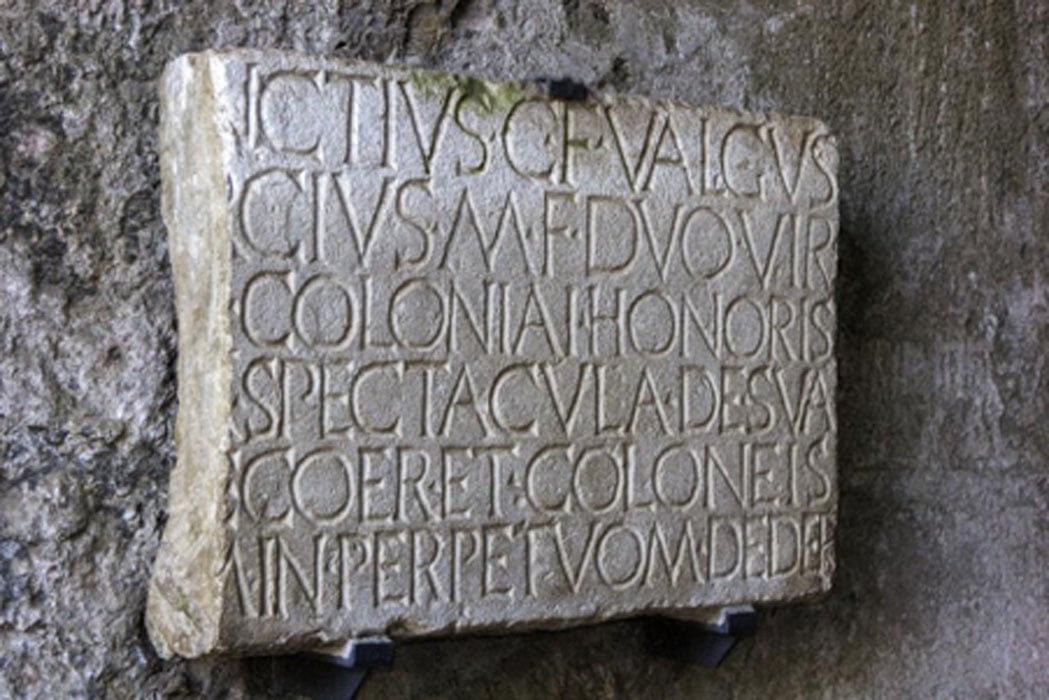Decoded Inscription Reveals Pompeii was a City of Extremes
The ruined city of Pompeii that was devastated by the eruption of Mount Vesuvius in 79 AD continues to provide insights into Roman history and society. An inscription on the tomb of an unidentified wealthy man is helping researchers to understand life in the ancient city. It reveals that Pompeii was a place of extremes - where the elite enjoyed lavish lifestyles and the poor sometimes starved.
The inscription was found on a tomb in the Pompeii Archaeological Park in 2017 and was deciphered by the park director-general Massimo Ossana. According to the Journal of Roman Archaeology the tomb was found “in the Stabian Gate area during renovation work on a public building, constructed in the early 19th century.”
It appears that it was damaged and looted in the 1800s. The Journal of Roman Archaeology reports that “The tomb is part of a necropolis that developed alongside an important gate in the S sector of the city walls.”
- Pompeii: The Ancient Roman City Frozen in Time
- Skeleton Found in Pompeii Belonged to Child Seeking Shelter from Deadly Volcanic Eruption
- House of Visual Delights Discovered in Pompeii
The Tomb of a Wealthy Man
An inscription in Latin was found on the monument. Sadly, the section of the tomb with the name of the person interred was destroyed, probably during the construction of the 19th-century building. It is suspected that it may be the final resting place of “Gnaeus Alleius Nigidius Maius, a man mentioned in other inscriptions from Pompeii,” reports Live Science.
This is because the tomb of his adoptive father, the duumvir or civic magistrate Marcus Alleius Minius, is located near the monument with the inscription. Maius was a very wealthy and influential man, according to the surviving documentary evidence, and he lived about 59 AD.

The peristyle of the House of Gnaeus Alleius Nigidius Maius (also known as The House of Pansa) in the ruined city of Pompeii. (Wildmountainscene/CC BY SA 3.0)
Banquets and Gladiators
The inscription describes the celebrations, “when the wealthy man was old enough to wear the "toga virilis" (a toga worn by an adult male citizen),” reports Live Science. It appears that the rich young man would throw a massive banquet that was served "on 456 three-sided couches so that upon each couch 15 persons reclined," according to the inscription. This engraving states that 6,800 guests attended the party.

‘The Romans of the Decadence’ (1847) by Thomas Couture. (Public Domain)
Since only citizens were likely to be invited to these celebrations it allowed Ossana to estimate how many lived in the city. According to Live Science, based on the engraving they “probably made up about 27% to 30% of Pompeii's population.” Only citizens, who were all adult males, had any political rights and dominated the city economically.
As if that was not lavish enough, the wealthy man staged some gladiatorial games to celebrate his coming of age. The inscription states that over 400 gladiators fought at these and that they lasted for a couple of days.
This could mean that there were 200 fights between the gladiators if they fought in single combat. The engraving also praises the scale of the games and claims that they were as grand as anything ever seen in a provincial Roman municipality.

‘Pollice Verso’ Jean-Léon Gérôme's 1872. (Public Domain)
Starvation and Unrest in Pompeii
This 2000-years-old engraving also tells us that life in Pompeii was very hard for the majority of people. There appears to have been a famine or food-shortages in the city for four years. It appears that the wealthy man distributed bread in order to alleviate the hunger of the poor.
According to Live Science, this could “be depicted in a famous mosaic from Pompeii, which shows bread being distributed during a famine.” It portrays a small group being given bread by a man in a toga, who was presumably from the wealthy class.
- Did Pliny Get It Wrong? Inscription Points to a Later Date for the Destruction of Pompeii
- Evidence Suggests an Underground of Roman Sorcery in Pompeii
- Decapitated Pompeii Man Was Not Killed By the Block

Sale of bread at a market stall. Roman fresco from the Praedia of Julia Felix in Pompeii. (Public Domain)
In 59 AD there was a major riot in the city, and this is attested to in the historical work of Tacitus. Based on the inscription it appears that the mad Emperor Nero had all the gladiators and some citizens expelled from the city. It is not known if the riot was linked to the food shortages in the city.
The engraving reads that the man buried in the tomb was able to persuade Nero to permit some of the citizens to return to the city. This is an indication of the political connections and wealth of the man.

Statue of The Roman Emperor Nero by Claudio Valenti, Anzio (anc. Antium) Italy. (CC BY SA 2.0)
The deciphering of the inscription allows us to better understand Pompeii’s society and politics. It shows that there was a large citizen class who enjoyed an affluent lifestyle and that there were many poor. The results of the deciphering of the inscription are only preliminary and more facts about the city destroyed in 79 AD could yet be revealed.
Top image: An example of an inscription found in the Pompeii ruins. Source: prosiaczeq /Adobe Stock
By Ed Whelan

















